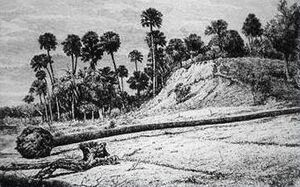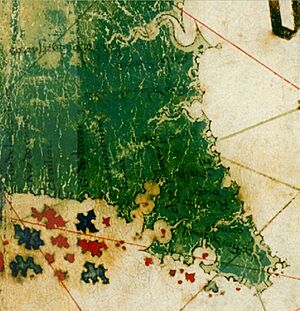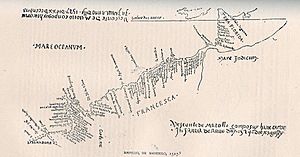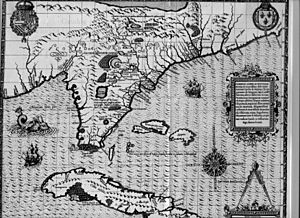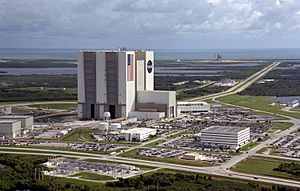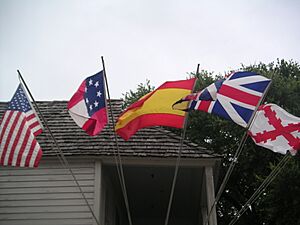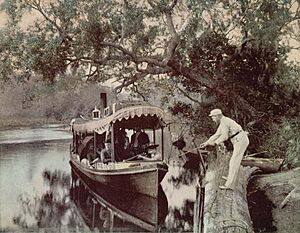History of Florida facts for kids
Quick facts for kids History of Florida |
|
|---|---|

The seal of Florida reflects the state's Native American ancestry
|
|
| Historical Periods | |
| Pre-history | until 1497 |
| Spanish Rule | 1513–1763 |
| British Rule | 1763–1783 |
| Spanish Rule | 1783–1821 |
| U.S. Territorial Period | 1822–1845 |
| Statehood | 1845–present |
| Major Events | |
| American Revolutionary War | 1775–1783 |
| War of 1812 | 1811–1814 |
| First Seminole War | 1817–1818 |
| Capitol moved to Tallahassee |
1824 |
| Second Seminole War | 1835–1842 |
| Constitutional convention | 1838 |
| Third Seminole War | 1855–1858 |
| Ordinance of Secession | 1861 |
| Civil War | 1861–1865 |
| 3rd Constitution | 1865 |
| Reconstruction | 1865–1868 |
| 4th Constitution | 1868 |
| 5th Constitution | 1885 |
| Great Migration | 1910–1930 |
| Land Boom | 1925–1929 |
| 6th Constitution | 1968 |
| Gore v. Harris 2000 Presidential Election |
2000 |
| Timeline | |
The history of Florida began when the first Native Americans arrived about 14,000 years ago. They left behind many clues about their lives. Florida's written history started with the arrival of Europeans. The Spanish explorer Juan Ponce de León was the first to write about the land in 1513. He named the peninsula La Pascua Florida, which means "Festival of Flowers." He chose this name because the land was green and beautiful, and it was Easter season.
This area was the first part of the United States mainland to be settled by Europeans. Since then, Florida has seen many groups of people move in. This includes French and Spanish settlers in the 1500s. New Native American groups also moved from other parts of the South. Free Black people and runaway slaves joined Native Americans, becoming known as Black Seminoles.
Florida was ruled by Spain for a long time, from the 1500s to the 1800s. It was briefly under Great Britain from 1763 to 1783. In 1821, Florida became a territory of the United States. Then, on March 3, 1845, Florida joined the U.S. as the 27th state.
Florida is called the "Sunshine State" because of its warm weather and many sunny days. Its sunny climate, beautiful beaches, and growing industries have attracted many people. Visitors and new residents from other parts of the U.S. and other countries have come to Florida since the Florida land boom of the 1920s. Florida's population became very diverse and its economy grew a lot during the 20th century. In 2014, Florida had over 19 million people. It became the third most populous state in the U.S..
Florida's economy has changed over time. It started with using natural resources like logging, mining, fishing, and sponge diving. People also did cattle ranching, farming, and citrus growing. Later, tourism, real estate, trade, banking, and retirement destination businesses became important.
Contents
Early History of Florida
First People of Florida
The first people, called Paleo-Indians, arrived in Florida at least 14,000 years ago. Back then, Florida was much larger and drier because glaciers held a lot of the world's water. Fresh water was mostly found in sinkholes. So, these early people lived near these water sources.
Archaeologists have found many tools and artifacts from these times. Some tools found in Marion County might be as old as 26,000 to 28,000 years!
Around 8000 BC, the climate became warmer and wetter. As glaciers melted, sea levels rose, making Florida smaller. The Paleo-Indian culture changed into the Early Archaic culture. More water meant people lived in more places. Discoveries at Windover Pond have taught us a lot about these people.
By 3000 BC, Florida's climate was similar to today. People lived near wetlands and built large shell middens (piles of shells). Some lived in big villages with earthwork mounds. Horr's Island had a large community and the oldest burial mound in the East, from about 1450 BC. People started making pottery around 2000 BC. By 500 BC, different regional cultures began to form in Florida.
The cultures in eastern and southern Florida developed on their own. The people living there when Europeans arrived were likely descendants of these early groups. In northern Florida, people started growing corn. But in southern Florida, tribes like the Calusa relied on the rich coastal environment. They built complex societies without farming.
When Europeans Arrived
When Europeans first came in the early 1500s, about 350,000 Native Americans lived in Florida. They belonged to many different tribes. The Spanish recorded nearly a hundred group names. Some were large, like the Apalachee with 50,000 people. Others were small villages. About 150,000 people spoke different dialects of the Timucua language.
Other tribes included the Ais, Calusa, Jaega, Mayaimi, Tequesta, and Tocobaga. Early explorers wrote about them, and archaeologists have learned more. Sadly, the populations of these tribes dropped sharply under Spanish rule. This was mainly due to new infectious diseases brought by Europeans. Native Americans had no natural immunity to these illnesses.
By the early 1700s, many Native American populations were very small. Tribes from the north, often with help from white colonists from Carolina, raided Florida. They burned villages and took captives to be sold into slavery. Many Florida villages were abandoned. Survivors sought safety in St. Augustine or hidden places. Many tribes disappeared during this time.
Some Apalachee people eventually moved to Louisiana and survived there. In 1763, when Spain gave Florida to the British, the remaining Native Americans were moved to Cuba. After this, the Seminole tribe formed in Florida. They were originally part of the Creek people from the north. They welcomed other groups and became a new, distinct tribe. Today, there are three federally recognized Seminole tribes: the Seminole Nation of Oklahoma, the Seminole Tribe of Florida, and the Miccosukee Tribe of Indians of Florida.
Colonial Florida: A Battleground
First Spanish Rule (1513–1763)
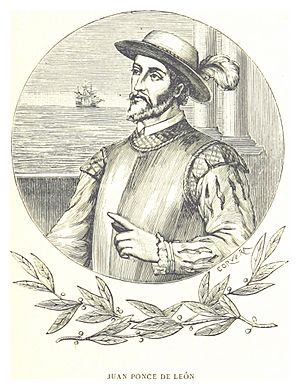
Juan Ponce de León is often credited as the first European to see Florida. But others might have been there before him. A map from 1502, the Cantino planisphere, shows Florida. Ponce de León's expedition in 1513 was the first official one. He named the land La Pascua de la Florida because he landed during Easter, which the Spanish called Pascua Florida (Festival of Flowers).
On April 7, 1513, Ponce de León landed on Florida's east coast, south of today's St. Augustine. His expedition then sailed around the Florida peninsula, through the Florida Keys, and up the west coast to Charlotte Harbor. There, they had a small fight with the Calusa tribe before returning to Puerto Rico. From 1513 on, the land was known as La Florida.
Other Spanish attempts to settle Florida were difficult. Ponce de León returned in 1521 to start a colony, but the Calusa drove him away. He died from his wounds in Cuba. Pánfilo de Narváez explored the west coast in 1528. His demands for gold led to conflict with native groups. Most of his expedition was lost at sea. Hernando de Soto landed in 1539 and explored the southeastern U.S., but found no gold and died. In 1559, Tristán de Luna y Arellano started a settlement in Pensacola, but it was abandoned after a hurricane.
The horse, which had disappeared from North America thousands of years ago, was brought back by European explorers in 1538. Some horses escaped and became wild.
In 1564, René Goulaine de Laudonnière founded Fort Caroline near modern-day Jacksonville. It was a safe place for French Protestant refugees. In 1565, Pedro Menéndez de Avilés founded San Agustín (St. Augustine). This is the oldest continuously inhabited European settlement in any U.S. state. From St. Augustine, the Spanish built Catholic missions.
St. Augustine was often attacked and burned. In 1586, English pirate Sir Francis Drake plundered and burned the city. Catholic missionaries used St. Augustine to build over 100 missions. They converted many natives, but revolts and diseases caused problems. Pirate attacks and British raids continued. Spain built strong forts like the Castillo de San Marcos (1672) and Fort Matanzas (1742) to protect the city.
Throughout the 1600s, English settlers from Virginia and the Carolinas moved south, pushing into Spanish territory. In 1702, English colonel James Moore and his Native American allies attacked St. Augustine. They burned the town but could not take the fort. In 1704, Moore burned Spanish missions in north Florida and killed Spanish-allied Native Americans. This opened Florida to slave raids, which hurt the native population.
The British and Spanish fought many times. In 1740, a large British force under James Oglethorpe attacked St. Augustine but could not take the Castillo de San Marcos. British colonists were upset that Spanish Florida offered freedom to enslaved Africans who converted to Catholicism. These free Black people settled in a community north of St. Augustine called Gracia Real de Santa Teresa de Mose. This was the first settlement of free Black people in North America.
British Rule (1763–1783)
In 1763, Spain traded Florida to Kingdom of Great Britain for control of Havana, Cuba. The British had captured Havana during the Seven Years' War. Almost all the Spanish people left Florida, taking most of the remaining Native Americans to Cuba. The British divided Florida into East Florida and West Florida.
The British built the King's Road connecting St. Augustine to Georgia. This road crossed the St. Johns River at a narrow point called "Cow Ford" by the British. The British government gave land to soldiers who fought in the French and Indian War to encourage settlement. Many British colonists moved to Florida, mostly from South Carolina, Georgia, and England. This was the first time many English-speaking people lived permanently in areas like Duval County and St. Johns County.
The British improved roads and started growing sugar cane, indigo, and fruits. They also exported lumber. Northeastern Florida grew economically under British rule. The British also brought their legal system, including trial-by-jury and county governments.
A Scottish settler named Dr. Andrew Turnbull brought about 1,500 indentured settlers from different parts of Europe to grow crops like hemp and sugarcane at New Smyrna. The colony faced many problems, including insect-borne diseases and Native American raids. Most crops did not grow well in Florida's sandy soil. The settlers were unhappy with their harsh conditions and Turnbull's rule. The settlement failed, and the survivors fled to St. Augustine. Their descendants still live in Florida today.
In 1767, the British moved the northern border of West Florida further north. During this time, Creek Indians moved into Florida and formed the Seminole tribe.
During the American Revolutionary War, the two Floridas remained loyal to Great Britain. Many Floridians were Loyalists. They did not send delegates to the Continental Congress. Spain, allied with France, captured Pensacola from the British in 1781. In 1783, the Treaty of Paris ended the war and returned all of Florida to Spanish control.
Second Spanish Rule (1783–1821)
After the British left, Spain had few officials and soldiers in Florida, and no new Spanish settlers came. Most British residents also left. This unguarded region became a safe place for escaped slaves and a base for Native American attacks against the U.S. The U.S. demanded that Spain control the area.
Americans from Georgia and South Carolina began moving into northern Florida. The Spanish could not stop them. These American and remaining British settlers became the ancestors of the people known as Florida Crackers.
These American settlers ignored Spanish officials. The British settlers who stayed also disliked Spanish rule. This led to a rebellion in 1810. They created the "Free and Independent Republic of West Florida" for 90 days.
In 1810, President James Madison claimed parts of West Florida for the U.S. The U.S. slowly took control of more of the area.
Seminole Indians in East Florida raided Georgia settlements and offered safety to runaway slaves. The United States Army often entered Spanish territory. This included the 1817–1818 campaign against the Seminoles by Andrew Jackson, known as the First Seminole War. The U.S. now controlled East Florida. Florida had become a problem for Spain, which could not afford to send settlers or soldiers. So, Spain decided to give Florida to the United States through the Adams-Onís Treaty in 1821.
Florida Becomes a U.S. Territory and State
Florida Territory (1822–1845)
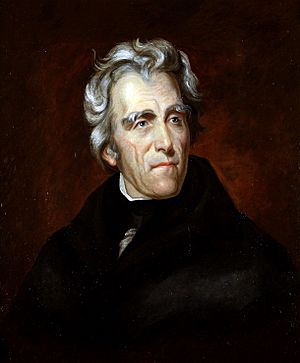
Florida became an organized territory of the United States on March 30, 1822. The Americans combined East Florida and West Florida. They chose a new capital, Tallahassee, because it was halfway between St. Augustine (East Florida's capital) and Pensacola (West Florida's capital).
Free Black people and Native American slaves, known as Black Seminoles, living near St. Augustine, fled to Havana, Cuba, to avoid U.S. control. Some Seminoles also moved further south. Hundreds of Black Seminoles and runaway slaves escaped from Cape Florida to The Bahamas.
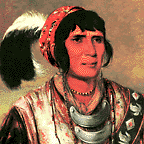
As more settlers came, there was pressure to remove Native Americans from their lands. Many settlers started large cotton and sugar plantations. The Seminoles helped and welcomed runaway Black people. This led to more conflicts between white settlers and Native Americans.
In 1832, the U.S. government signed the Treaty of Payne's Landing with some Seminole chiefs. It promised them land west of the Mississippi River if they left Florida. Many Seminoles left, but others stayed to defend their land. White settlers wanted all Native Americans removed, by force if needed. In 1835, the U.S. Army arrived to make them leave.
The Second Seminole War began in late 1835 with the Dade Massacre. Seminoles attacked Army troops, killing almost all of them. Between 900 and 1,500 Seminole warriors used guerrilla tactics against the U.S. Army for seven years. Osceola, a brave young war leader, became a symbol of the war. He was captured while negotiating in 1837 and died in prison. The war ended in 1842. Most Seminoles were forced to move west of the Mississippi River. A few hundred remained hidden in the Everglades.
Statehood (1845)
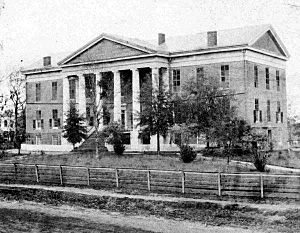
On March 3, 1845, Florida became the 27th state of the United States. Its first governor was William Dunn Moseley.
Almost half of Florida's population were enslaved African Americans. They worked on large cotton and sugar plantations in north-central Florida. Many of these enslaved people had come from Georgia and the Carolinas.
In the 1850s, the government tried to convince the remaining Seminoles to leave. More Army patrols led to fighting. The Third Seminole War lasted from 1855 to 1858. Most remaining Seminoles, mainly women and children, moved to Indian Territory. A small number continued to live in the Everglades.
Before the Civil War, Florida had the smallest population of the Southern states. It relied on plantation farming. By 1860, Florida had 140,424 people. About 44% were enslaved, and fewer than 1,000 were free Black people.
Civil War and Aftermath
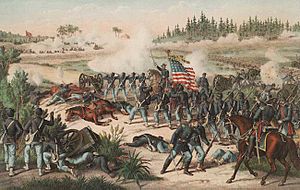
After Abraham Lincoln was elected in 1860, Florida joined other Southern states in leaving the Union. Florida seceded on January 10, 1861. Less than a month later, it became one of the first members of the Confederate States of America.
Florida was an important supply route for the Confederate Army. Union forces blocked Florida's ports. Union troops occupied major ports like Cedar Key, Jacksonville, Key West, and Pensacola. Many small fights happened in Florida. The only major battle was the Battle of Olustee near Lake City.
After the war, a state convention was held in 1865 to rewrite the constitution. Florida met the requirements of Reconstruction. This included approving changes to the U.S. Constitution. Florida was readmitted to the United States on June 25, 1868.
After Reconstruction, white Democrats worked to regain political power. They succeeded by 1877. They passed laws from 1885 to 1889 to make it harder for Black people and poor white people to vote. This helped white Democrats control the state.
By 1900, about 44% of Florida's population was African American. But they were largely prevented from voting. This meant they could not serve on juries or be elected to government jobs. White Democrats also passed Jim Crow laws. These laws created racial segregation in public places and transportation.
Florida Since 1900
In 1900, Florida was mostly farms and wild areas. Most people lived near the Georgia border. The population grew from 529,000 in 1900 to 18.3 million in 2009. This huge growth started with the land boom of the 1920s. Florida went from being a quiet place to a popular spot for land investors. Many people from the Southeast moved to Florida. Developers also invested in areas like Miami and Palm Beach, attracting even more people.
When the stock market crashed in 1929, house prices dropped. Florida was hit hard by the Great Depression and the land bust. But federal aid programs under President Roosevelt helped the state.
Florida's economy fully recovered with the buildup for World War II. The warm climate and the invention of air conditioning made the state a popular place to live. After 1945, many people from the Northeast and Midwest moved to central and southern Florida. Today, about 63% of Floridians were not born in the state.
The 1920s Boom
The 1920s were a time of great wealth for much of the U.S., including Florida. New railroads opened up large areas for development. This led to the Florida land boom of the 1920s. Investors bought and sold land quickly in new communities like Miami and Palm Beach. Miami grew rapidly with land speculation and building projects. Many people bought land in Florida without even visiting, using agents. By 1924, a main topic in state elections was how to attract more businesses and build good roads for tourists. The population grew from less than one million in 1920 to over 1.2 million in 1925.
By 1925, there were not enough buyers for the high-priced land, and the boom ended. The 1926 Miami Hurricane badly damaged the city and further hurt the real estate market. In 1928, another hurricane, the 1928 Okeechobee hurricane, hit southern Florida. It caused a huge storm surge from Lake Okeechobee, killing over 2,000 people and destroying towns.
The Great Depression and World War II
The Great Depression began in 1929. Florida's economy was already struggling from the land boom's collapse. The New Deal programs (1933–40) helped Florida. The Works Progress Administration (WPA) built sewers, roads, and schools. The Civilian Conservation Corps (CCC) provided work camps for young men.
From 1930 to 1935, college students started visiting Fort Lauderdale, Daytona Beach, and Panama City Beach for spring break. The 1960s movie Where the Boys Are made Fort Lauderdale even more popular. But when too many students came, the city passed laws to control activities. Students then moved to Daytona Beach.
Florida legalized gambling in 1931. By 2014, there were 30 such places, bringing in $200 million in state taxes.
Before World War II, the Army and Navy decided to use Florida as a main training area. Many military bases were built or expanded, including Naval Air Station Pensacola and Naval Air Station Jacksonville. Eglin Air Force Base and MacDill Air Force Base were also developed. During the Cold War, Florida's location near the coast and Cuba made these bases even more important.
Space Industry and Population Growth
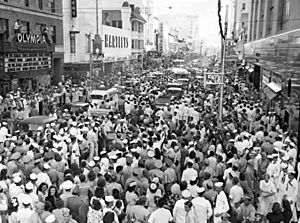
Because Florida is close to the equator, it was chosen in 1949 as a test site for the country's new missile program. Patrick Air Force Base and the Cape Canaveral launch site grew in the 1950s. By the early 1960s, the Space Race was in full swing. The space program brought a huge boom to the communities around Cape Canaveral. This area is now known as the Space Coast and is home to the Kennedy Space Center. It is also a major center for the aerospace industry. All U.S. manned orbital spaceflights, including the trips to the Moon, have launched from Kennedy Space Center.
After World War II, Florida changed a lot. Air conditioning and the Interstate highway system made it easier for people to move from the north. In 1950, Florida was the 20th most populated state. Fifty years later, it was the 4th. Low taxes and warm weather made Florida a popular place for retirees from the Northeast, Midwest, and Canada.
The Cuban Revolution in 1959 led to many Cubans moving to South Florida. This made Miami a major center for business and trade with Latin America. People from Haiti, other Caribbean countries, and Central and South America continue to move to Florida today.
Civil Rights Movement
Like other Southern states, Florida had many African American leaders in the civil rights movement. In the 1940s and 50s, Harry Moore built the National Association for the Advancement of Colored People (NAACP) in Florida. He helped many Black people register to vote. In the 1940s, Black voter registration increased from 5% to 31%.
However, some white groups resisted these changes. There were bombings against African Americans in Florida in 1951–1952. By 1960, African Americans made up 18% of Florida's population. This was a smaller percentage than in 1900, but their numbers had grown.
Environment and Hurricanes
Scientists have focused on protecting the fragile Everglades. In 2000, Congress approved the Comprehensive Everglades Restoration Plan (CERP) to restore the Everglades ecosystem.
Hurricane Andrew hit Homestead in August 1992 as a very powerful Category 5 hurricane. It killed 40 people, damaged or destroyed 100,000 homes, and left over a million people without power. Damages were estimated at $20–30 billion. The hurricane also badly hurt the region's insurance industry.
The western panhandle of Florida was heavily damaged in 1995 by three storms: Allison, Erin, and Opal. Opal hit as a Category 3 hurricane.
Florida suffered greatly during the 2004 Atlantic hurricane season. Four major storms hit the state: Hurricane Charley, Hurricane Frances, Hurricane Ivan, and Hurricane Jeanne. Damages from these storms were estimated to be at least $22 billion. In 2005, South Florida was hit by Hurricanes Katrina and Wilma. The panhandle was hit by Hurricane Dennis.
Florida has always been at risk from hurricanes. But as more people and buildings are on the coast, the risk of damage increases. Also, development has changed natural wetlands that used to help absorb storm energy.
Environmental issues include the slow process of restoring the Everglades. There has been pressure to drill for oil in the eastern Gulf of Mexico, but large-scale drilling off Florida's coasts has been stopped so far.
Tourism in Florida
In the late 1800s, Florida became a popular tourist spot. Henry Flagler's railroads expanded into the area. In 1891, railroad owner Henry Plant built the fancy Tampa Bay Hotel in Tampa. Flagler built the Florida East Coast Railway from Jacksonville to Key West. Along the way, he built grand hotels for his passengers, like The Ponce de León Hotel in St. Augustine and The Royal Poinciana Hotel in Palm Beach.
In February 1888, President Grover Cleveland and his family visited Florida. He supported tourism to the state. Flagler's railroad connected cities on Florida's east coast, leading to more growth there. Later, highways like I-95 and I-75 helped tourism and city growth even more.
Theme Parks in Florida
Florida's first theme parks opened in the 1930s. These included Cypress Gardens (1936) near Winter Haven and Marineland (1938) near St. Augustine.
Disney World
Disney chose Orlando for a new version of their Disneyland Park. In 1971, the Magic Kingdom, the first part of Walt Disney World Resort, opened. It became Florida's most famous attraction, drawing millions of visitors each year. This led to other attractions and a lot of housing development.
The Orlando area became a huge international resort with many theme parks. These include Universal Orlando Resort, SeaWorld, and Wet 'n Wild.
Images for kids
See also
 In Spanish: Historia de Florida para niños
In Spanish: Historia de Florida para niños


